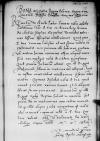Habuimus cf. Ioannes DANTISCUS to Bona Sforza Braunsberg (Braniewo), 1543-10-10, CIDTC IDL 7036, letter lost⌊litterascf. Ioannes DANTISCUS to Bona Sforza Braunsberg (Braniewo), 1543-10-10, CIDTC IDL 7036, letter lost⌋ Paternitatis Tuae ex Braunsberg (Braniewo), town in Ermland (Warmia), 19 km NE of Elbing (Elbląg), port on the Vistula Lagoon, a member of the Hanseatic League⌊BraunsbergBraunsberg (Braniewo), town in Ermland (Warmia), 19 km NE of Elbing (Elbląg), port on the Vistula Lagoon, a member of the Hanseatic League⌋ 1543-10-10⌊decima die Octobris1543-10-10⌋ scriptas, ex quibus novitates externas diffuse descriptas intelleximus. Quas quia Paternitas Tua una cum litteris suis ad nos saepius mittere non praetermittit, non parvam illi habemus gratiam. Ubi autem horum recentius adhuc aliquid emerserit, non neglegat nobis de eisdem significare.
Quod Wilhelm V Der Reiche (Wilhelm of Jülich-Cleves-Berg, William I of Cleves, William V of Jülich-Berg) (*1516 – †1592), 1538-1543 Duke of Guelders and Zutphen, 1539-1592 Duke of Jülich-Cleves-Berg. During the 3rd Guelderian War that followed, France he was an ally to Guelders against Charles V. His predecessor, Duke Charles of Guelders, also concluded an alliance with France (MÜLLER)⌊ducem IuliacensemWilhelm V Der Reiche (Wilhelm of Jülich-Cleves-Berg, William I of Cleves, William V of Jülich-Berg) (*1516 – †1592), 1538-1543 Duke of Guelders and Zutphen, 1539-1592 Duke of Jülich-Cleves-Berg. During the 3rd Guelderian War that followed, France he was an ally to Guelders against Charles V. His predecessor, Duke Charles of Guelders, also concluded an alliance with France (MÜLLER)⌋ attinet, qui, ut regis Ferdinandi Maria of Austria (*1531 – †1581), daughter of Ferdinand I Habsburg and Anna Jagiello; second wife of Wilhelm V Der Reiche⌊filiamMaria of Austria (*1531 – †1581), daughter of Ferdinand I Habsburg and Anna Jagiello; second wife of Wilhelm V Der Reiche⌋ in matrimonium accipiat, sicut ex eisdem novitatibus intelleximus, Charles V of Habsburg (*1500 – †1558), ruler of the Burgundian territories (1506-1555), King of Spain as Charles I (1516-1556), King of Naples and Sicily, King of the Romans (1519-1530), Holy Roman Emperor of the German Nation (elected 1519, crowned 1530, abdicated 1556); son of Philip I the Handsome and Joanna the Mad of Castile⌊caesarea maiestasCharles V of Habsburg (*1500 – †1558), ruler of the Burgundian territories (1506-1555), King of Spain as Charles I (1516-1556), King of Naples and Sicily, King of the Romans (1519-1530), Holy Roman Emperor of the German Nation (elected 1519, crowned 1530, abdicated 1556); son of Philip I the Handsome and Joanna the Mad of Castile⌋ nititur, cupimus describat nobis Paternitas Tua, quot annos priorem uxorem tenuit, et si aliquos liberos secum procreavit. Scimus enim quod Wilhelm V Der Reiche (Wilhelm of Jülich-Cleves-Berg, William I of Cleves, William V of Jülich-Berg) (*1516 – †1592), 1538-1543 Duke of Guelders and Zutphen, 1539-1592 Duke of Jülich-Cleves-Berg. During the 3rd Guelderian War that followed, France he was an ally to Guelders against Charles V. His predecessor, Duke Charles of Guelders, also concluded an alliance with France (MÜLLER)⌊illeWilhelm V Der Reiche (Wilhelm of Jülich-Cleves-Berg, William I of Cleves, William V of Jülich-Berg) (*1516 – †1592), 1538-1543 Duke of Guelders and Zutphen, 1539-1592 Duke of Jülich-Cleves-Berg. During the 3rd Guelderian War that followed, France he was an ally to Guelders against Charles V. His predecessor, Duke Charles of Guelders, also concluded an alliance with France (MÜLLER)⌋ regis Galliae Jeanne d’Albret (*1528 – †1572), daughter of Henry II, King of Navarre, and Marguerite of Angoulême, who was the sister of King Francis I of Valois⌊neptimJeanne d’Albret (*1528 – †1572), daughter of Henry II, King of Navarre, and Marguerite of Angoulême, who was the sister of King Francis I of Valois⌋ habuit in uxorem, sed quam diu in matrimonio cum eadem mansitsitque illis aliqua proles, incognitum est nobis, ideo certiores cupimus reddi a Paternitate Tua.
Quae bene valeat.


 BCz, 1601, p. 710
BCz, 1601, p. 710